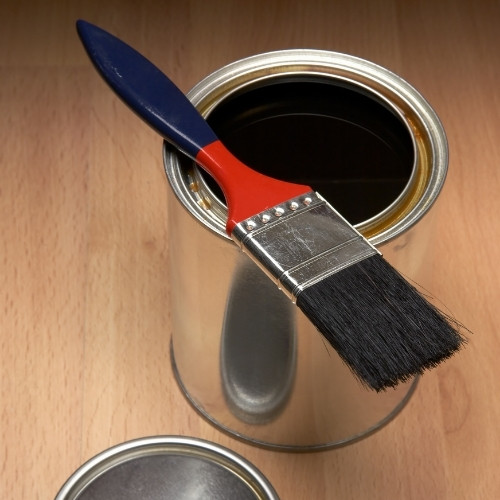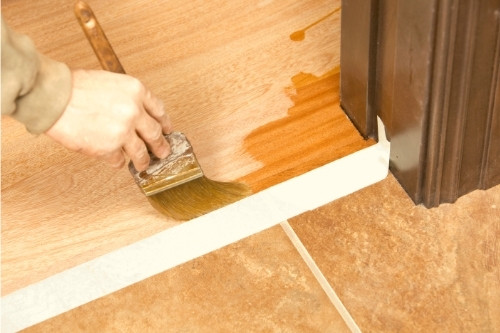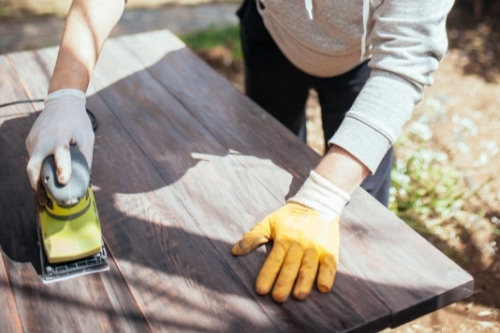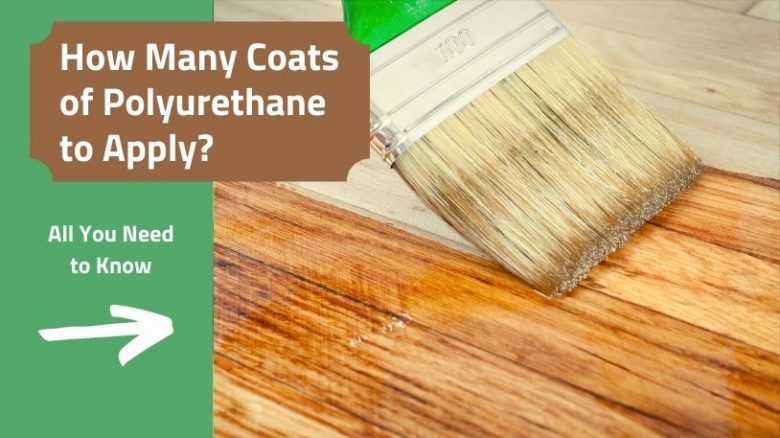Polyurethane is a clear, durable, attractive surface finish that is easy to apply to wood. However, if you apply too many coats, your project looks encased in plastic; too few, it doesn’t wear well. You should normally use between two and four coats of polyurethane; however, a lot depends on whether the polyurethane is water-based or oil-based.
When I started woodworking, oil-based polyurethane was the only choice I had, and I used it everywhere. These days, we’re spoiled for choice with oil-based, water-based, wipe-on products and specialized polyurethane with stains and additives.
This article will run through readers’ common questions about polyurethane, where to use it, and how best to apply it. So stay with me for the next couple of minutes, and we’ll answer all the queries you may have.
What is polyurethane?

Polyurethane is a synthetic polymer or plastic made from an isocyanate and resin blend.
Polyurethane is produced and used in large quantities and is considered a commodity plastic. Uses include a surface covering for wood, foam manufacture, and insulation, while the automotive industry uses it extensively for panels, seals, and oil-filter applications.
How many coats of polyurethane to apply?
As a general rule, apply at least two coats of oil-based polyurethane. Floors, kitchen furniture, and other high-traffic areas will need three coats. For water-based polyurethane, five coats are applied to achieve adequate protection.
Is one coat of polyurethane enough?
Applying just one coat of polyurethane is not enough. The first coat of polyurethane you apply will have imperfections, may look patchy, and could have bubbles in it. Think of the first coat as a sealer coat, with most absorbed into the wood. Subsequent coats level out the surface and give a greater finish consistency.
Are four coats of oil-based polyurethane too many?
There are applications where you will need to apply four coats of oil-based polyurethane, such as floors. If you apply four coats of oil-based polyurethane to a floor, you will be fine. However, when applying multiple coats of oil-based product, there is the risk of making the coating too thick. When the coat is too thick, it can then crack or sheet off, causing more work to repair.
How many coats to apply on:
Wooden flooring
My preference for wooden flooring is oil-based polyurethane. It’s a little tougher than a water-based product, making it hard-wearing, and it costs less. I’d apply three or four coats.
If you choose to use water-based polyurethane on your floors, the budget for applying six coats is as follows: While you’re adding more coats, each dries quickly, so you’ll find that when using water-based products, you’ll be able to use the room 24 hours earlier than if you use oil-based ones.
Kitchen tables
Kitchen tables take some knocks and therefore need protection. I’d use three coats of oil-based polyurethane or five coats of water-based polyurethane to ensure you get the desired finish and durability.
When using the oil-based product, thin the first coat down with mineral spirits to act as a sealer, then apply two additional full-thickness coats, sanding in between each once dry.
Wooden countertops
I’d treat wooden countertops the same way as the kitchen table example. Three coats of oil-based polyurethane, with the first thinned with mineral spirits. If using a water-based product, apply four or five coats.
We often get asked about the food safety aspect of polyurethane when used in the kitchen. Once fully cured, you can be comfortable that the polyurethane surface poses no danger to you or your family.
Stairs
Much depends on whether you have a carpet runner on the stairs to reduce foot traffic damage. If the stairs are protected, you could get away with two coats of oil-based or three coats of water-based. If not, treat the stairs with three coats of oil-based polyurethane or five when using a water-based product.
Furniture
Use two coats if you’re using oil-based polyurethane on furniture. Don’t thin the first coat, but carefully sand with 220 to 320-grit sandpaper between coats to get the quality of finish you require. If using water-based polyurethane, three coats should be sufficient, with a similar light sanding between coats.
Butchers blocks
A lot of our readers ask how many coats of polyurethane to apply on a butcher’s block, and the answer is very simple: zero. I wouldn’t be using polyurethane on a butcher’s block. It simply won’t stand up to the knife work it’ll receive. Instead, use a food-safe finish such as Tung Oil or Walnut Oil to nourish and seal the wood.
How to apply polyurethane to wood?

The basics of applying polyurethane are no different from that of paint or stain. Be sure the surface to which you’ll apply it is clean, dry, and sanded to the finish you require. Always remove dust and grit by using a vacuum or a painter’s tack rag to ensure you don’t end up with grit in the finish.
When stirring polyurethane before use, I always stir slowly and carefully; otherwise, you’ll entrap air into the liquid, which ends up as bubbles on the surface of your project. They can be problematic to remove.
If the wood is old, I like to thin the first coat of polyurethane when I’m using an oil-based product. I do this using a two-to-one ratio of two polyurethane and one mineral spirit. Applying this as a first coat soaks into the thirsty timber and helps seal it. I skip this step if I’m using water-based polyurethane as it’s thin enough already.
I don’t like using rollers with polyurethane as they can add bubbles to the surface. My choice is a brush or spraying. A floor finish applicator is another application method that is quick and provides a good finish when applying polyurethane to your floor.
Always allow each coat to dry fully and then sand lightly. Sanding levels the surface and provides a keying surface to assist adhesion between coats. Do not sand the final coat.
Read More: How to Apply Polyurethane to Wood
How long should you wait between coats?
Drying time is when you see the benefits of water-based polyurethane. The water-based product will be dry enough to sand in two to three hours in most climates. The oil-based polyurethane will need 12 to 24 hours before sanding or use.
Polyurethane tends to dry on the surface first, creating a film. Yet, under the surface, the product is still tacky. Try to sand or use the item too early, and you’ll be creating considerable damage to the finish, which will require time-consuming remedial work. Patience is everything here; don’t be tempted to rush in.
Related: How Long Does it Take for Polyurethane to Dry
Should I sand polyurethane between coats?

Yes, you should, no matter which polyurethane you use. The sanding is not just to get rid of dust and bumps, as some claim, but it’s also important to create a keying surface for the next layer, particularly with oil-based products.
Oil-based polyurethanes don’t like bonding to themselves without some form of scuffing of the surface. If you don’t sand, you won’t see the longevity you need from the surface finish as the layers start to delaminate. That aside, it’s also true that sanding does give you a much smoother and high-quality finish by leveling the imperfections, brush marks, and dust left in the last coat.
How to sand polyurethane?
Once a coat is fully dry, use 220 to 320-grit sandpaper and lightly sand the surface, either by hand or with an orbital sander. The keyword here is light; there’s no point removing everything you just put on. You’re simply looking to level the surface and provide a key for the next coat. Be sure to dust and clean the surface thoroughly; use a vacuum or a painter’s tack rag. Be sure not to sand the final coat.
Can you apply polyurethane over the stain?
Yes, you can. Applying an oil-based polyurethane over an oil-based stain is straightforward, as the stain soaks well into the wood. Just be sure to sand the stained wood before application of the polyurethane.
However, when applying an oil-based polyurethane over a gel-based stain, you risk lifting some of the stain as the gel-based product sits more on the surface. In that case, use a water-based polyurethane, or use a coat of shellac first and then apply your oil-based polyurethane. In all cases, ensure the stain is well dry and cured before applying your chosen surface finish.
Read More: How Long to Let Stain Dry Before Applying Poly
Can you apply polyurethane over paint?
Yes, you can. Be sure the paint is in good condition if it’s old or well-cured if recently applied. To ensure the new paint is properly cured, I’d leave it a good week.
Clean the surface with soapy water, then rinse and dry. Lightly sand with no rougher than 120 grit sandpaper to level the paint and create a keying surface, then apply the polyurethane. The use of water-based or oil-based polyurethane is based on your preference, but remember that water-based works better with lighter colors and oil-based polyurethane with darker colors.
Oil-based vs. water-based polyurethane
There are seven points to consider when deciding between oil-based or water-based polyurethane. Your particular circumstances and answers to each will dictate your final choice.
Color
Water-based polyurethane dries clear and does not enhance or alter the color of the underlying wood. It also does not change color over time. Oil-based polyurethane has an amber cast, which slightly darkens and enhances the natural timber. Oil-based polyurethane can also darken further with age.
Permanence
Oil-based polyurethane lasts for approximately 10 years when correctly applied.
High-quality water-based polyurethanes, when applied with care, can also last up to 10 years. Lower-quality water-based products usually make it five years before a reapplication is required.
Oil-based polyurethane is softer than water-based products, making it more resistant to scratching.
Time to dry
Water-based polyurethane takes around two to three hours to dry. Oil-based products can take around 8 to 12 hours to dry, depending on warmth and humidity.
With water-based polyurethane, you can recoat or use the finished item much more quickly than with oil-based products.
Odor
The polyurethane of either type releases strong odors until it is completely dry. With water-based products drying as rapidly as they do, the problem of smell in indoor spaces is greatly reduced, with a room becoming available for use far quicker than when using the oil-based equivalent.
Clean up
Water-based products win hands down here, with clean-up using water or soapy water, a quick and painless exercise. Oil-based polyurethane requires mineral spirits or paint thinner, with greater issues around flammability and disposal.
Coats required
Oil-based polyurethane is a thicker product and, therefore, requires fewer coats to achieve adequate protection. Water-based products are thinner and raise the wood grain upon application, so you require double the number of coats you normally apply with an oil-based product to get a smooth finish.
Ease of application
Oil-based polyurethane is simple to apply. It dries slowly, allowing a more leisurely application with time to correct any drips or mistakes. Water-based products dry quickly, so you need experience to get a perfect finish.
Cost
Water-based polyurethanes cost two to three times the price of oil-based products. Coupled with the increased number of coats required, if budget is a driving factor in your decision on which to use, oil-based will be cheaper.
Read More: Oil vs Water-Based Polyurethane
Summary
Polyurethane is a great product due to its ease of application and resistance to knocks and water. Whatever product you select, oil or water-based, follow the manufacturer’s instructions for application, as they can differ. Be sure to prepare the wood correctly, and allow sufficient time for each coat of polyurethane to dry before sanding lightly. Done carefully and with patience, you’ll be rewarded with a long-lasting and lovely finish that protects and enhances the color and grain of the underlying timber.

